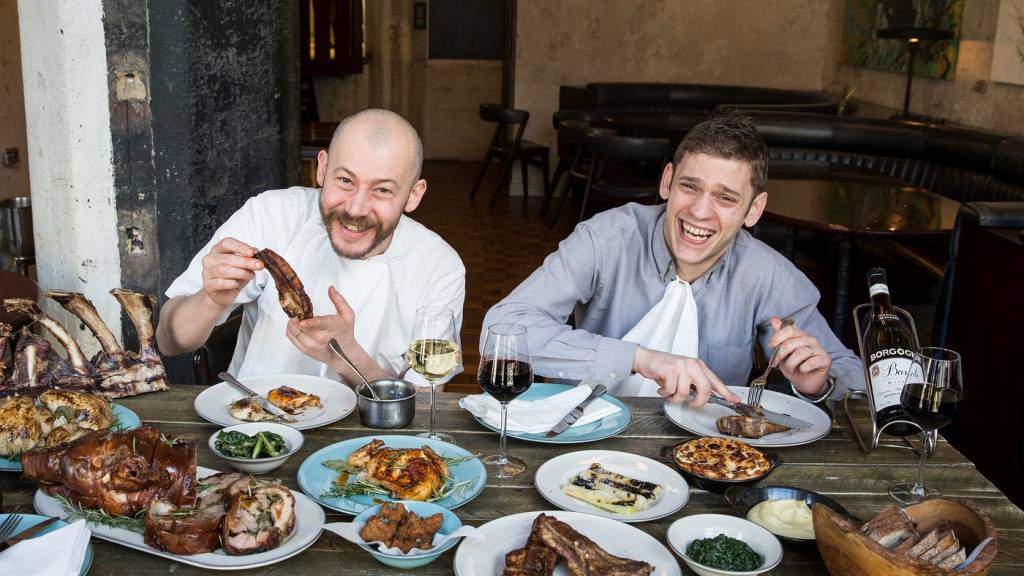Union Street Café Italian Roast Porchetta
Monday 24 April 2017

Union Street Café’s Davide Degiovanni reveals the secrets of good porchetta, Italy’s favourite way to roast pork.If you cook porchetta at home you’ll be eating it for a week, warns Union Street Café’s head chef Davide Degiovanni. Think hot roast on Sunday, antipasto on Monday, sliced for a sandwich Tuesday, minced for a burger on Wednesday, and so on. But that, after all, is one of the great things about cooking a huge Sunday roast: it makes a great base for meals for the rest of the week.
Italian family tradition
Porchetta – deboned and stuffed pork roast – is particularly associated with the cooking of Tuscany, Umbria, the Abruzzo Marche, Lazio and Rome. Traditionally it was made with a whole pig and the stuffing included its offal, but the ready-made porchetta you find on sale today tends to be shaped from selected cuts and simply stuffed with herbs.
When Davide was growing up in Italy, his family would come together to butcher pigs before Christmas, making bacon, ham and salami from the various cuts. One of the pigs would be made into porchetta, using the family recipe, and taken to the local bakers to be cooked in their huge wood-fired oven.
You may not feel like tackling a whole pig! But Davide does recommend trying suckling pig porchetta at home, which, being smaller, is easier and faster to prepare and cook.
How to cook porchetta
‘The important thing is to choose a nice porchetta,’ says Davide. ‘Not too fat, not too dry. Season it with rock salt, and you can play around with the peppers: brown, white, pink, green. Use some nice fresh chopped herbs – especially sage – and a touch of chilli if you like.’
Leave the seasoned meat to cure in the herbs and spices for at least a day; this will help make the skin crisp. Then, on the day of roasting, take it out of the fridge early in the morning so that it has time to come to room temperature, and be sure to pat the skin dry.
Davide recommends slow-roasting at a low temperature, however you could raise the heat and cook it in as little as three hours. ‘But things you take time over are always better,’ he says.
‘When you cook it on a very low heat, you just need to fire up the oven at the end of roasting to make the pork skin nice and crispy,’ he advises. ‘Put it in the oven at 130°C in the early morning and it will be ready by early afternoon. Turn it to 210°C for the last ten minutes.’
Italian Sunday lunch
Although many people think the best roasts are British, Italian cuisine has some great Sunday lunch ideas. At Union Street Café, Davide likes to offer family-style dishes including spatchcock chicken, and whole fish roast on the bone.
‘When I was a kid, my mother would do chicken and ribs on Sundays and I was the one opening the door every 15 minutes to baste them with a rosemary branch and a baste of white wine, olive oil and herbs,’ he recalls.
How to brine meat
For a sensational pro-level twist, Davide recommends brining meat before roasting. ‘Whether it’s a fillet or pork or beef, this makes it richer, tender and more compact,’ he explains. You can submerge meat (or poultry) a simple brine of water, salt and herbs; some chefs like to include white or red wine. Lean cuts benefit especially from brining as it helps keep them juicy. Leave the meat in the brine for about an hour per 500g.
For more great Sunday dinner ideas, check out Gordon Ramsay Restaurants Great British Roast campaign, running all through spring, using our hashtag #MoreThanARoast. And to enjoy Davide’s Italian twists on the best Sunday lunch in London, book Mangia & Bevi at Union Street Café, served noon till 5pm every Sunday.

 Gordon Ramsay Restaurants
Gordon Ramsay Restaurants 